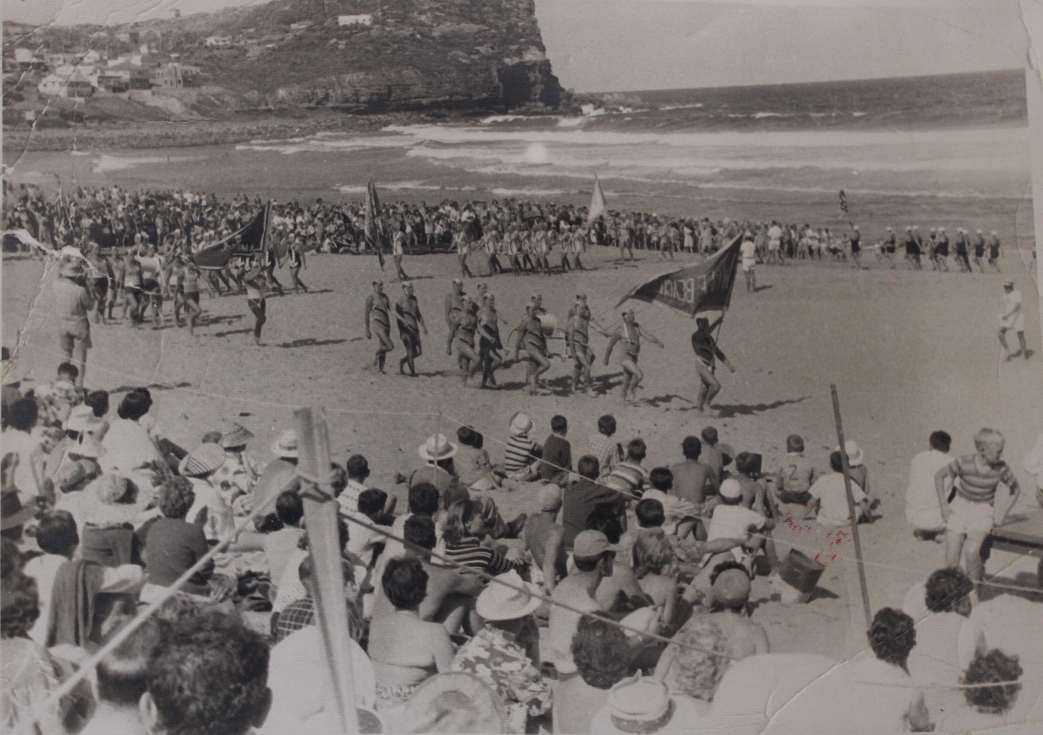Avalon Beach Norfolk Pines: to Honour those who served – anzac day 2023 history precursors
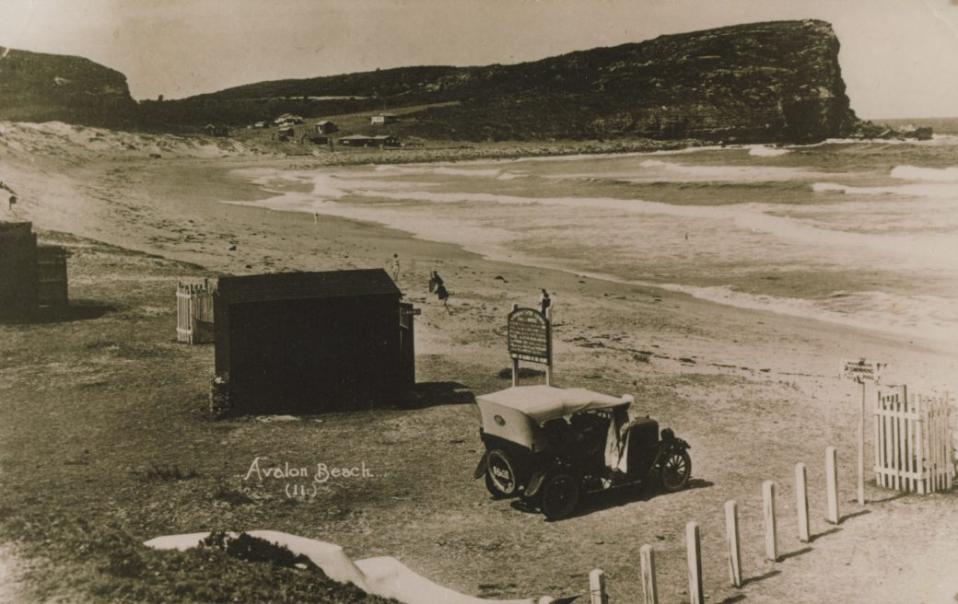
As we head towards the Autumn school holidays and ANZAC Day Commemorative Services on Tuesday April 25th, 2023, soon after school resumes - a few insights into human modified landscapes will be shared to Honour and Commemorate those who served, along with those made during conflicts changes, including the Tank Traps of Bungan-Mona Vale-Bayview as requested by a reader a few years back - those records have been found.
But to lead out - some trees in a local park. There are a number of these in our area to honour those who served, there is Manly Warringah War Memorial Park, known by locals as Manly Dam, listed by the NSW Government on the State Heritage Register earlier this year.
Forestville War Memorial Playground was established by ex-service people to not only honour their mates but to also serve as a LIVING memorial that would welcome in the sounds of people and children's laughter.
There have also been a lot of trees planted - Soldiers Avenue of Honour at Freshwater was just one of many planted out across the nation after the loss of so much life in WWI, many of whom were without a grave site to visit as their remains were left in the country they fell in. [1.]
Avalon Beach, which was just commencing as a subdivision during the years 1916-1921, did not have an RSL or cenotaph until after WWII - the first living Memorial placed here are the Norfolk Pines you still in place today, and were replacements of those that had been planted earlier and failed.
See snippet below –
‘’ It came from A. J. Small’s scrapbook via his youngest daughter Muriel who has since passed. She was a patron of the Avalon Beach Historical Society in 1990s.
Not sure of the ‘double row of trees’?’’ - Geoff Searl OAM, Pres. ABHS (Geoff has been helping with this research)

from Manly and Warringah News, October 12th, 1945.
The Warringah Shire Council Meeting of November 6th 1945 records:
Item (56) Narrabeen Sub-Branch RSSAILA 30/10/45, regarding planting of trees at Avalon in "memory of the fallen", and asking the following questions - (a) when did Council grant permission, and to whom, for the planting of trees "in memory of the fallen"; (b were any representatives of soldier or other Service organisations invited to attend the ceremony; (c) if not, asking that Council see that in future functions the President and Councillors and representatives of Service organisations are invited to attend. Cr. Forster explained verbally that the tree-planting had been carried out as a "hasty job", that there had been no dedication ceremony, but that provision had been made for one tree to be planted by an Ex-Servicemen's Association. Council Resolved, - That the Association be informed the Council had no, knowledge of the ceremony, and if and when the Council arranges such a function the Association will be invited to be present. (Crs. Green, Bathe) (57) Avalon Beach Process Assoc.,31/10/45, referring to tree- planting ceremony at Avalon Beach, stating members are of the opinion it is wrong to permit any one Association to interfere with public reserves, particularly where a wide difference of opinion exists, and requesting answers to the following questions (a) who authorised the tree-planting; (b) who selected the site; a) who organised the alleged Dedication Ceremony; (d) why was the public ignored, particularly residents of the area; and..(e) why were Servicemen's Associations ignored. Council Resolved:- That the Association be informed the trees were planted in replacement of trees formerly planted by the Council; and that the Council had no knowledge of the function. (58)-'Narrabeen Ex-Servicemen’s Club, 1/11/45, also regarding, tree-planting at Avalon and asking for information as to when the memorial planting took place, on whose authority, and what reasons can be advanced for holding such a ceremony without any Service organisations being invited to attend, Resolved; - That the Club be informed of the position.
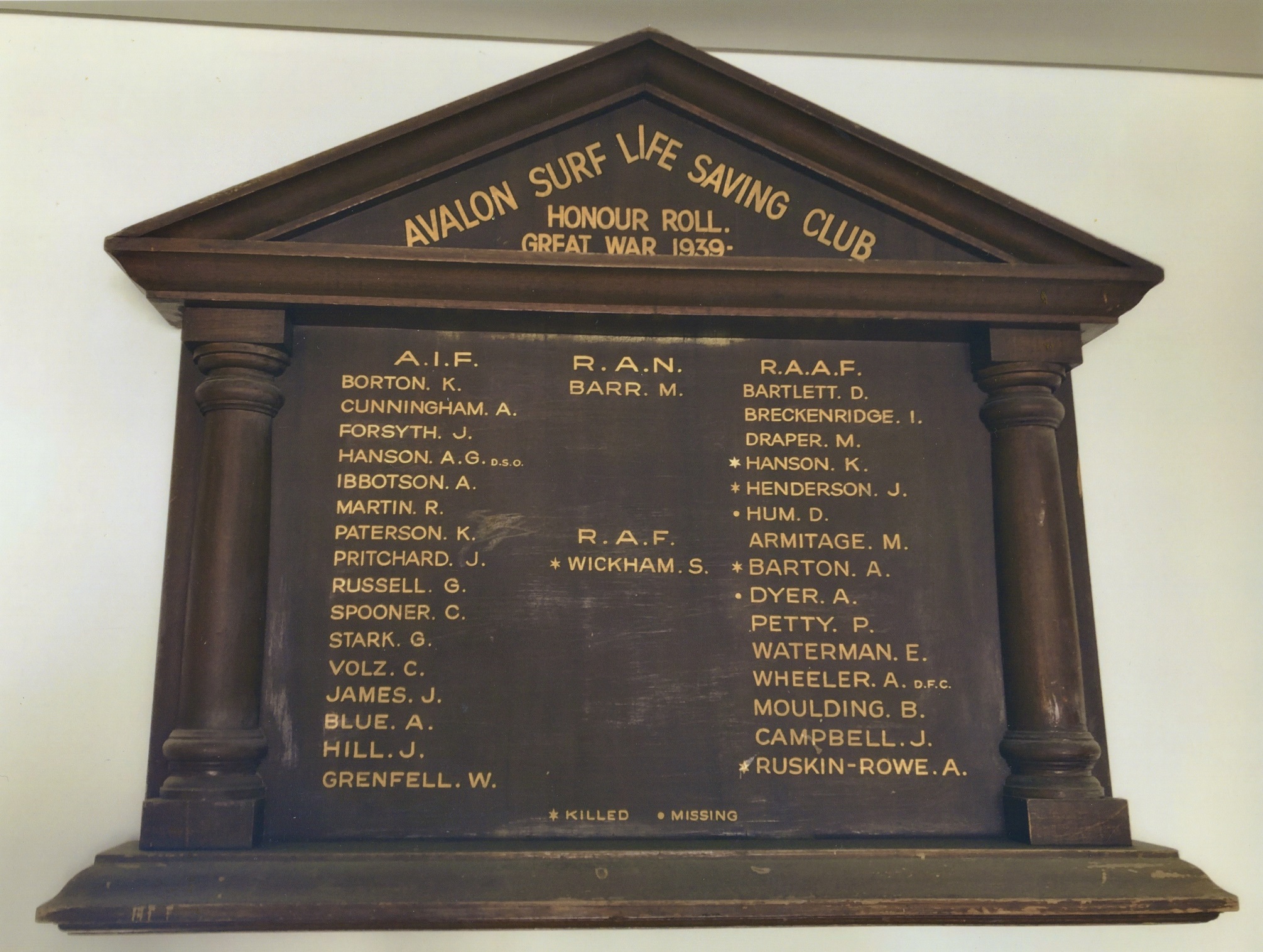
Avalon Beach SLSC Honour Board for WWII, shows five lost their lives serving in this conflict. Photo: Geoff Searl OAM
The tribute is particularly poignant when you consider that all of the current members of the then Avalon Beach SLSC signed up to serve, necessitating the patrolling of the beach by called in from elsewhere members such as Doug Crane and Reg Wood. A few insights from newspapers from the past demonstrate how quickly everyone enlisted to serve:
Surf Club To Sell Boat
Due to a big loss of members through enlistments, Avalon Surf Club has decided to sell its surf boat.
It is regrettable that a surf club should have to dispense with such a necessary part of its equipment," said Mr. J. Dillon, publicity officer of the Surf Association,- yesterday. "Avalon may not have been a strong club, but it has fulfilled all requirements of the surf association, maintaining a beach patrol, and so on." The boat, is practically new, as the club took delivery of it only last season. Sale price is £75. Surf Club To Sell Boat (1940, December 3). The Daily Telegraph (Sydney, NSW : 1931 - 1954), p. 16. Retrieved from http://nla.gov.au/nla.news-article248821361
ONLY 2 LIFESAVERS GUARD AVALON BEACH
Only two of Avalon surf club's pre-war membership of 22 are now on patrol. They are Walter Simmonds, 45-year-old president. and Ree Ray, club captain. Mr. Ray, who lives in Drummoyne, travelled 30 miles, and Mr. Simmonds (Potts Point) 25 miles to patrol the beach last season. They were responsible for 20 rescues. Last year they had part-time assistance from four bronze medallion recruits. Those four members have since joined the fighting forces. The club will cease to function this season unless its membership grows.
The Liquid Fuel Control Board rejected Mr. Ray's application for petrol to' allow him to travel to Avalon to perform what he claims is a public duty. Mr. Simmonds said yesterday that the club was prepared to engage a professional lifesaver.
"The Warringan Shire Council and residents of the Avalon district will each pay 50 per cent, of the life-saver's wages," he added. "During the Christmas holidays and other busy periods there are more than 1000 lives to protect."
Any paid lifesaver available for the position can contact Mr. Simmonds (phone BW 3701). ONLY 2 LIFESAVERS GUARD AVALON BEACH (1941, October 14). The Daily Telegraph (Sydney, NSW : 1931 - 1954), p. 10. Retrieved from http://nla.gov.au/nla.news-article247623568
One of the first Avalon Beach residents to be lost in World War II, and an early patrol member of the Avalon Beach SLSC was the only son of the first storekeeper in Avalon Beach who lost his life soon after the conflict commenced:
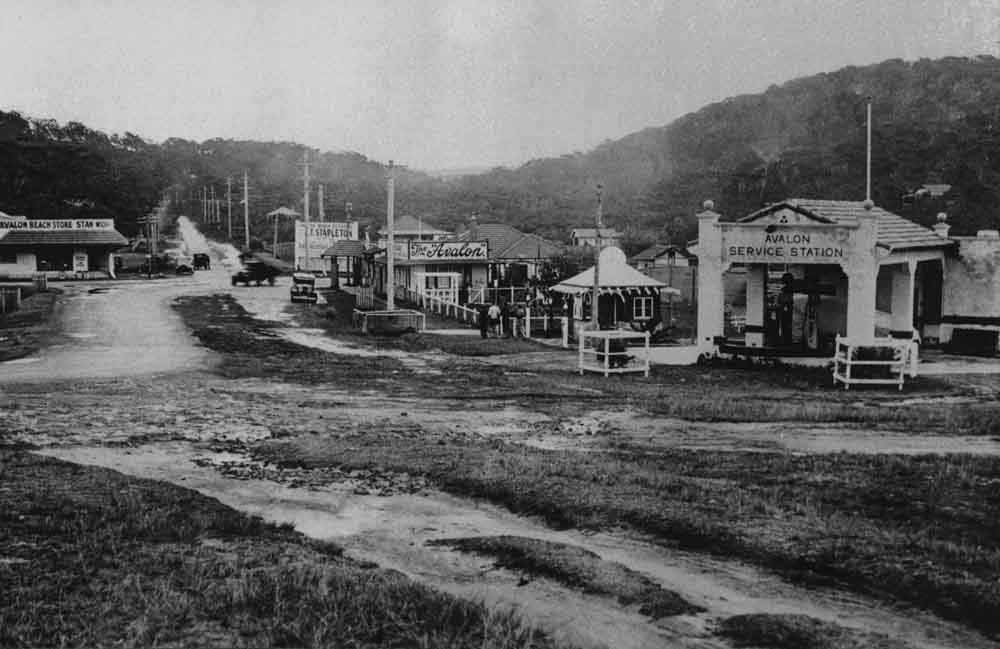
While Stan was out making deliveries Grace would run the store, including the Post Office within the store, redirected telephone calls, handled holiday lettings for the cottages and homes as they sprang up, raised her children and as a nurse, acted as the local GP until a doctor had settled in the valley of Avalon.
On a tragic note, she also took the telegram which informed her of her son being shot down over Germany in 1939 whilst a flier for the Royal Air Force.
WICKHAM.-December 18, killed on Western Front, serving with the R.A.F., Pilot Officer Stanley Macdonald (Mac) Wickham, beloved son of Stan and Grace, and brother of Lois, of Avalon Beach. Family Notices (1939, December 23). The Sydney Morning Herald (NSW : 1842 - 1954), p. 10. Retrieved from http://nla.gov.au/nla.news-article17642165
AIRMAN KILLED
Son of Stan Wickham
Pilot-Officer Stanley McDonald Wickham (22), who died on Monday while serving with the R.A.F., was a son of Mr. Stan Wickham of Rugby Union fame, and a grandson of the late Mr. Sydney Wickham, who preceded Mr. Syd. Davies as town clerk of Parramatta. His parents, who reside at Avalon, received the news yesterday In a cable from the British Air Ministry.
"Although the cable just says he was killed in an aircraft accident," Mr. Stan Wickham said last night, "we think he was serving on the Western Front.
Educated at North Sydney High School young Wickham gained his advanced A flying certificate as a member of Sydney Aero Club. He left Australia nearly two years ago to take up a four year commission with the R.A.F. AIRMAN KILLED (1939, December 20 - Wednesday). The Cumberland Argus and Fruitgrowers Advocate (Parramatta, NSW : 1888 - 1950), p. 1. Retrieved from http://nla.gov.au/nla.news-article106204407
AUSTRALIAN IN R.A.F. CASUALTY LIST
LONDON, Monday. 4
A Royal Air Force casualty list announces that Pilot-Officer S M Wickham who was born at Parramatta (NSW) has been killed on active service. Pilot Officer Wickham's father lives at Avalon near Palm Beach. AUSTRALIAN IN R.A.F. CASUALTY LIST (1940, January 2). The Argus (Melbourne, Vic. : 1848 - 1957), p. 3. Retrieved from http://nla.gov.au/nla.news-article11289589
Wickham Lane, running beside the Post Office’s present site is named after the Wickhams. The request initially came from residents soon after their son lost his life, and then another came from the RSL and would clearly have been made to honour the young man lost as well as the family who gave so much to Avalon Beach during its formative years. Warringah Shire Council Minutes of Meetings provide:
Meeting held February 2nd, 1940: E. Morehead: 16/1/40, suggesting that as old Barrenjoey Road is now being put into good order it is worthy of a new name, and perhaps could be named after a British Stateman, or better still, called Wickham Road, as the son of Mr. Wickham, at whose store the road finishes, has paid the supreme sacrifice for his country. Motion Lost. Name to remain the same.
Meeting held on July 11th, 1950: Avalon Beach RSSAILA, 4/7/50 requesting that the name "Wickham Avenue' be given to the lane adjoining the R.S.L. Clubhouse instead of "Wickham Place", as already approved. Resolved; That the Council agree to the change of name. (Crs. Butcher, Harries)
Meeting held on September 5th, 1950: 5) Avalon Branch RSSAILA, 23/8/50, inquiring whether the planting Council would be prepared to supply ornamental trees for planting along Wickham Avenue, leading to the Branch's hall from Avalon Parade. Resolved, - That trees be supplied to the Sub- Branch for planting et about 30-ft. spacing, as recommended by the Engineer.
Meeting held on April 30th, 1951: Avalon Branch RSSAILA, 9/4/51, requesting that consideration be given to laying a concrete path along Wickham Avenue from Avalon Parade to the land owned by the Sub-Branch, stating Avenue that the Sub-Branch has, at its own expense, placed quantities of sand in the Avenue, and requesting that early consideration be given to this request as Wickham Avenue is the only access 19. to the Hall. Resolved, - That £40 be voted for work on this roadway, the work to be treated as urgent. (Crs. Berry,Wheeler)
The Lane's name originally extended right through to Dunbar Park. That section between Avalon Parade and the park was officially changed in 1988 to honour a local doctor. The section that runs from the post office to Avalon Public School remains 'Wickham Lane'.
Three other 1930's members were the Hanson boys. As Geoff Searl OSAM explained in his precursor for the Avalon Beach SLSC's 90th anniversary celebrations in 2015, where the ABHS President put together another great exhibition for the surf club he is a Lifer Member of;
''Three sons were born to Sydney dentist, Arthur Cecil Hanson and his wife Mildred Blanche Faviell. Arthur George Hanson (known as ‘Tom’ to most) was first born at Hunters Hill in 1911. Geoffrey Faviell Hanson followed in 1914 and Kenneth John Hanson completed the family.
Prior to 1920 Arthur bought a block of land on the corner of Avalon Parade and Ruskin Rowe on which he built a two-room cottage. It consisted of a bedroom and a kitchen/dining room but both were surrounded on 3 sides by a generous open verandah where later children of the families spread their mattresses and camp beds. He called the cottage ‘Keilor’ after the north-west suburb of Melbourne from where Blanche’s family hailed. The family spent considerable time at ‘Keilor’ travelling down from Hunters Hill and later Killara in Arthur’s bull-nosed Hupmobile.
The 3 boys loved the water and decided to join the surf club. In the photo taken in 1925 of the meeting on the steps of ‘Avalon’ which resulted in the formation of the Avalon Beach SLSC, Dr Hanson is standing on the steps alongside A .J. Small, the owner and developer of Avalon Beach.
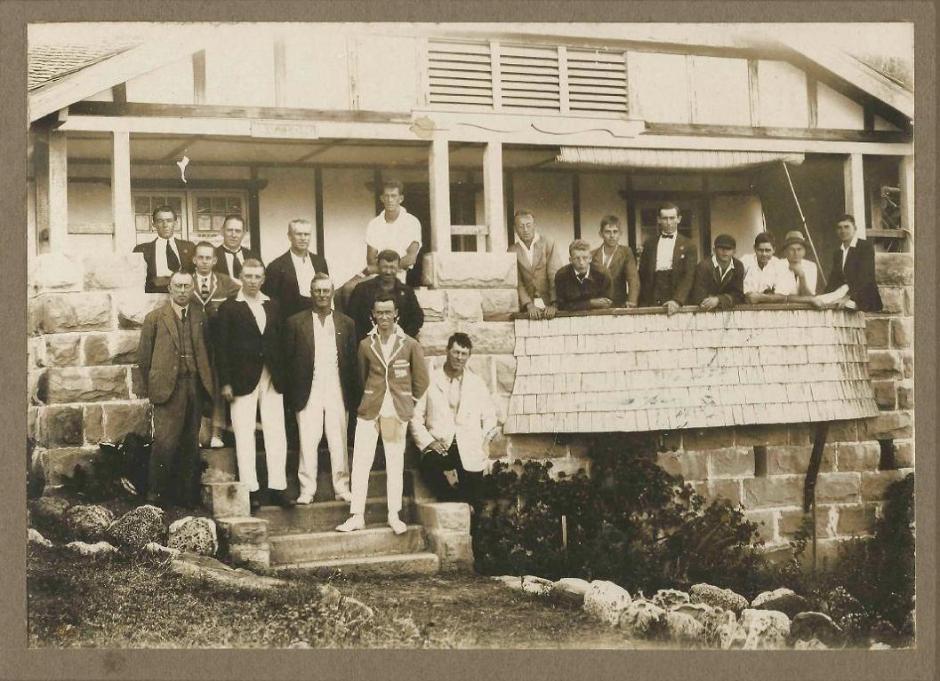
A.G. (Tom) and Geoff were in the same successful Bronze Medallion squad on 7 April 1935 (the Club’s 2nd squad). The 3rd brother Ken obtained his Bronze Medallion with the Club’s 3rd squad on 29 March 1936. Geoff gained the Club’s 2nd Instructor’s Certificate with the 4th squad which passed on 31 January 1937. Geoff became Club Captain one year later and it is recorded that he held a card night at the home which raised 6 pounds which went to the new boat under construction (launched on 4 December 1938). Geoff served as Hon. Treasurer in 1939 and rowed competitively in the new boat under the new Boat Captain and Sweep, Gordon Brown.
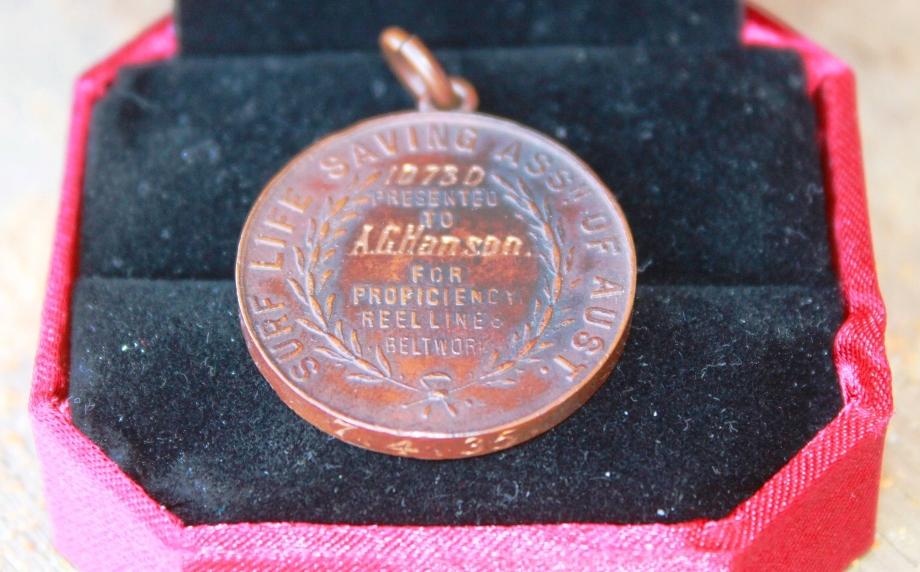
In November 1939 Tom Hanson was among several members who left to join the AIF. The last of the Club’s Active Members to leave was Ken Hanson when he joined the RAAF in January 1941. Photo: ABHS
Dr Hanson died in 1935 and so never knew of the death of his youngest son Ken who perished when his Liberator bomber was shot down over Celebes (Sulawesi) in 1945. Geoffrey died in 1976 but it was Tom the eldest son who kept the Hanson flag flying.
In November 1942 F Troop was flown into Popondetta under the command of Major Hanson. He was nicknamed Black Tom, while the battery’s code-name was Blackforce. After the war he joined the CMF reaching brigadier in 1957 when he was commander of the artillery’s 2nd Division. He died in Sydney in 1999 at the age of 87. ''
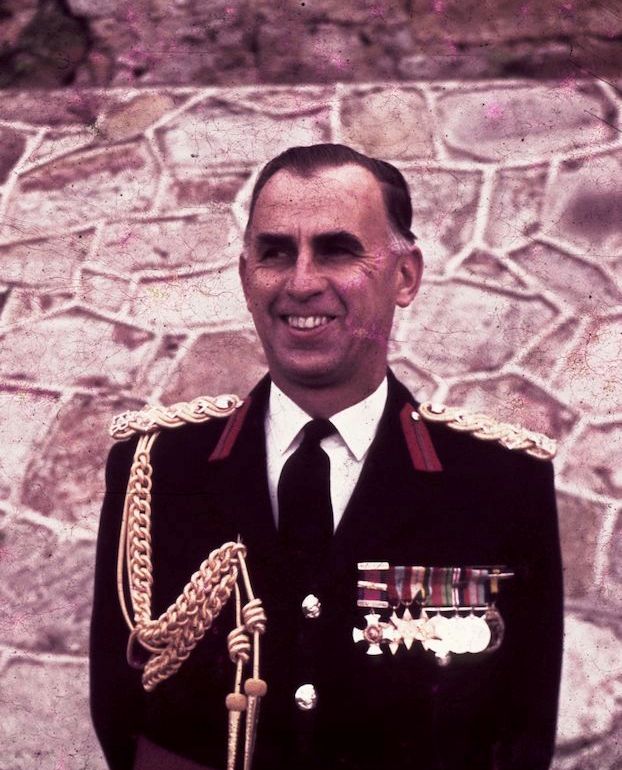
Above: A.G. (“Tom”) Hanson in full regalia as A.D.C. with his DSO and Bar medals. Photo: ABHS
Arthur George Hanson: Service Number: NX144
Rank: Captain
Unit: 2/1st Field Regiment
Service: Army
Conflict: Second World War, 1939-1945
Award: Mention in despatches
Date of London Gazette: 30 December 1941
Location in London Gazette: Page 7358, position 91
Arthur George Hanson: Service Number: NX144
Rank: Major
Unit: 2/1st Field Regiment
Service: Army
Conflict: Second World War, 1939-1945
Award: Distinguished Service Order
Date of Commonwealth of Australia Gazette: 23 December 1943
Location in Commonwealth of Australia Gazette: Page 2798, position 5
Date of London Gazette: 23 December 1943
Location in London Gazette: Page 5574, position 14
Arthur George Hanson: Service Number: NX144
Rank: Lieutenant Colonel
Unit: 2/1st Field Regiment
Service: Army
Conflict: Second World War, 1939-1945
Award: Bar to Distinguished Service Order
Date of Commonwealth of Australia Gazette: 6 March 1947
Location in Commonwealth of Australia Gazette: Page 745, position 10
Date of London Gazette: 6 March 1947
Location in London Gazette: Page 1089, position 17
Avalon Beach was already a popular place to visit by 1939, so Reg and Doug's contribution saved lives, even if they were quite young to be undertaking this work. They too had to travel from out of the area and stayed in the clubhouse on Avalon Beach during the Season to look after those who visited the beach.
Inspired by the remarkable work performed by members of the Woolloomooloo Police Boys' Club in patrolling Avalon Beach, a batch of youngsters from the Leichhardt Police Boys' Club became qualified life-savers during the week-end. They were tutored by Constable Ray Murdoch, a member of the Freshwater Club, and amazed Surf Life Saving Association examiners by their proficiency and confidence. Murdoch gained his instructors' certificate, and M. W. Koller, R. H. Marshall, D. J. Marshall, A. Hensley, and W. P. Drury their bronze medallions. K. Taylor, who is only 15, secured his qualifying certificate. Although these youths are not attached to any club, they are now qualified life-savers, and are eligible for entry to any registered surf life-saving club. In the last two years more than 40 awards have been made to members of police boys' clubs. SURF LIFE-SAVERS AS HUNTERS. (1944, December 19). The Sydney Morning Herald (NSW : 1842 - 1954), p. 8. Retrieved from http://nla.gov.au/nla.news-article17932315
Photographs from the past and present show the beachfront before and after this second lot of Norfolk Pines, dedicated to those who served, were planted.
Compare these Norfolk pine tree protection boxes from the 1925 panorama by Rex Hazelwood – these must have been those that failed, with (1930). [Motor cars, some with tarpaulins attached, parked adjacent to Avalon Beach, New South Wales, 1930, 2] Retrieved from http://nla.gov.au/nla.obj-147290238, which shows none - and
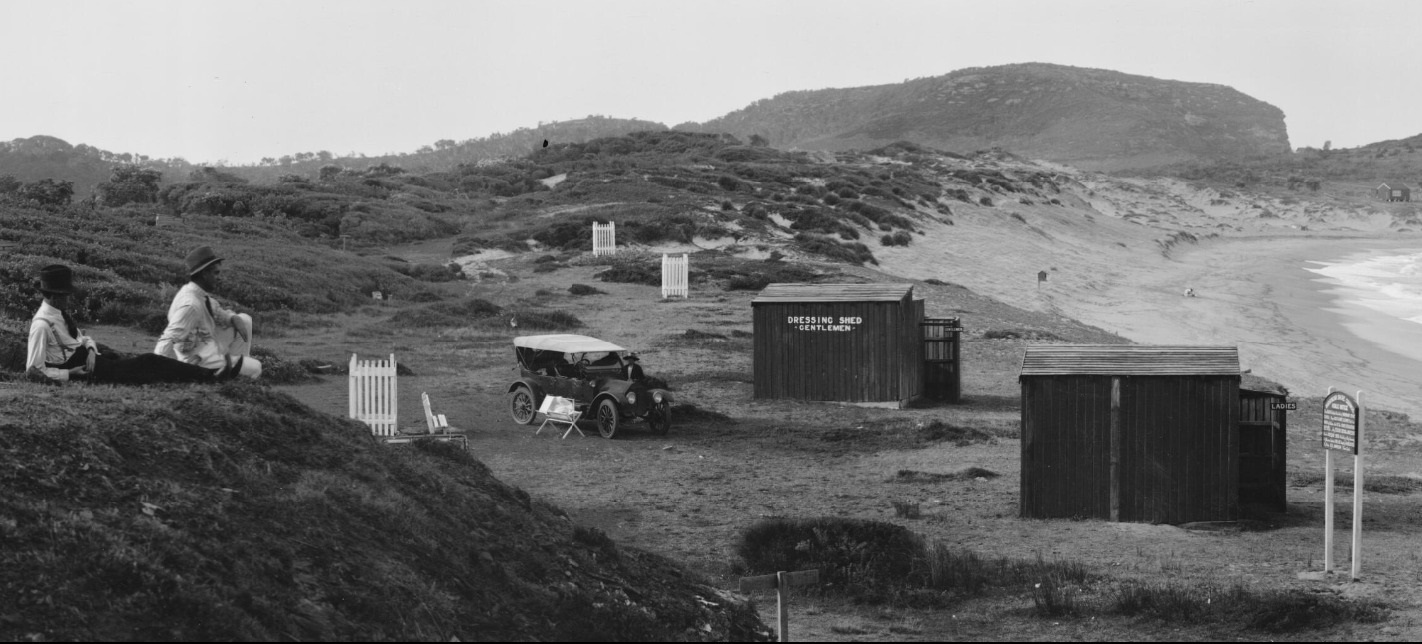
.jpg?timestamp=1675634298072)
.jpg?timestamp=1675634326944)
.jpg?timestamp=1675634351632)
'Panorama of beachgoers at Avalon Beach', New South Wales, ca. 1925 section enlarged to show dressing sheds on Avalon Beach at this point in time. The beginnings of Norfolk Pines, planted by A J Small are in the white wicker tree guards. Image No.: nla.pic-vn6217968 by EB Studios, part of the Enemark collection of panoramic photographs, courtesy National Library of Australia Retrieved from http://nla.gov.au/nla.obj-162503014
Avalon [From the air], 1949, Item e23711_0001_c, courtesy Mitchell Library, State Library of New South Wales, where you can see Norfolk pines along the southern beachfront that must have been 4-5 years of age by then:
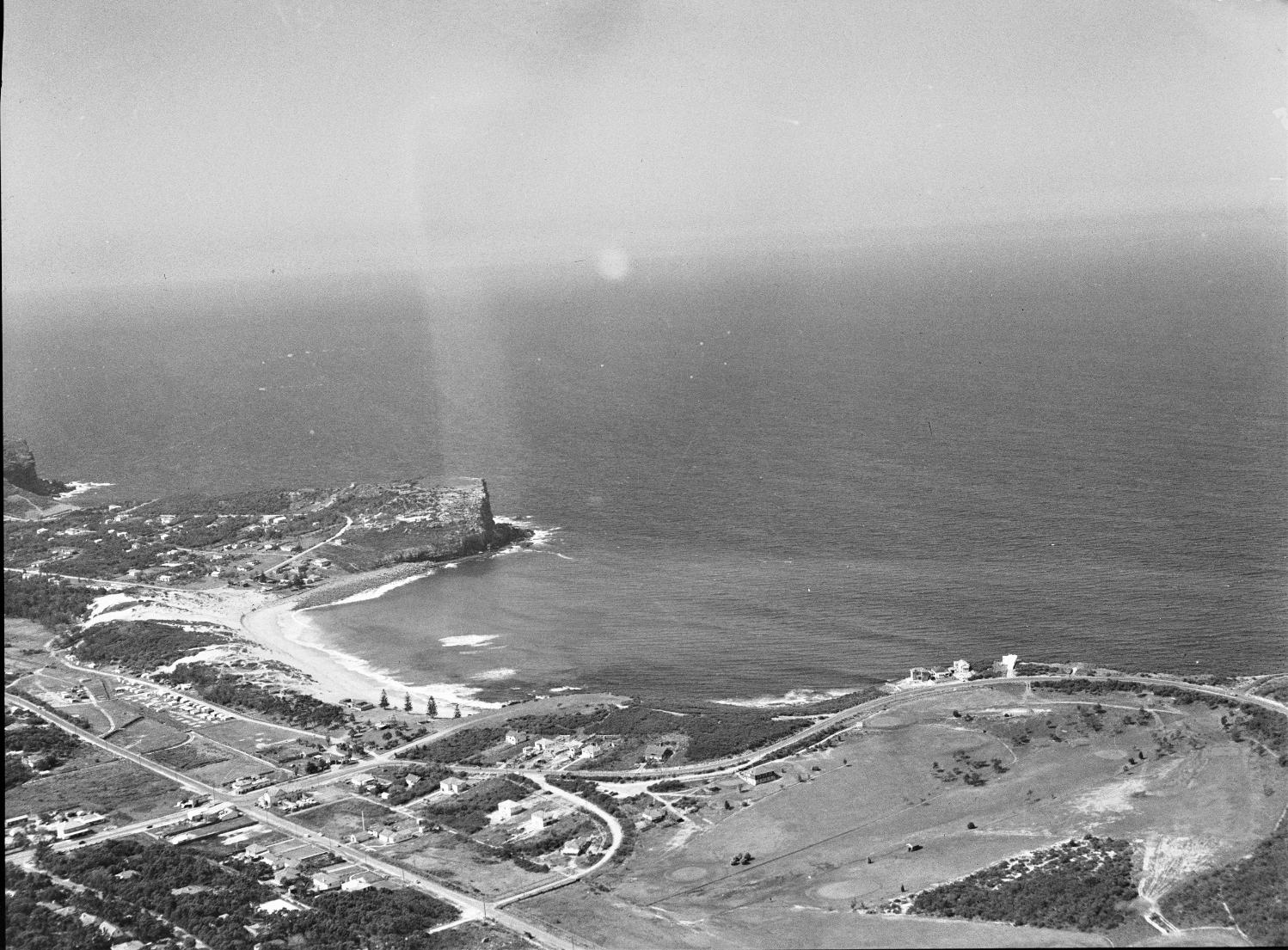
Hurley, Frank. Avalon Beach & surroundings [Aerial views, Sydney, New South Wales] circa 1950-52 (enlarged section from to show camping ground alongside Careel Creek and surrounds - including the Norfolk pines on south end of beach; 4 can be seen and the tip of a 5th one right at the southern edge, tucked behind the bank rise) Retrieved from http://nla.gov.au/nla.obj-160005527
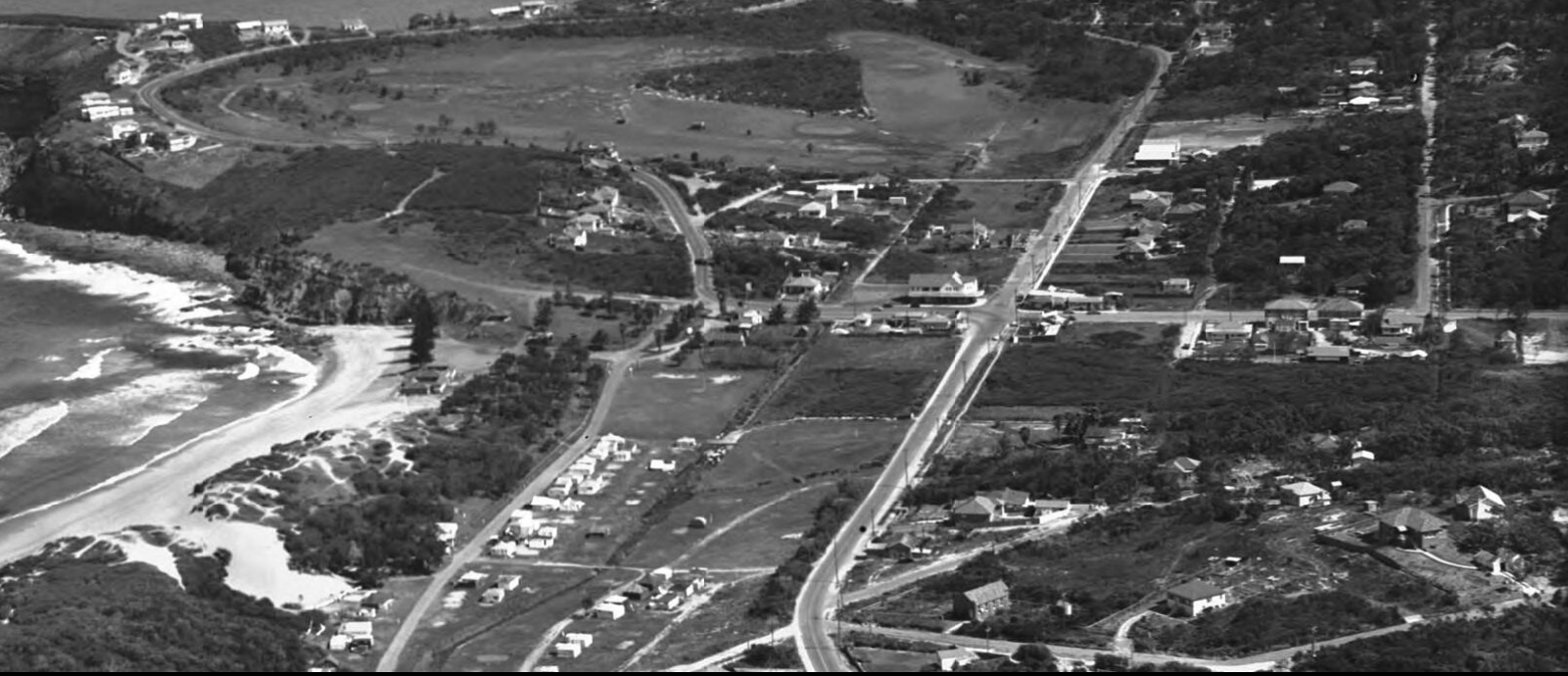
Hurley, Frank. (1910). View through trees of Avalon beach and headland, 1950's, New South Wales Retrieved from http://nla.gov.au/nla.obj-160158036 -:
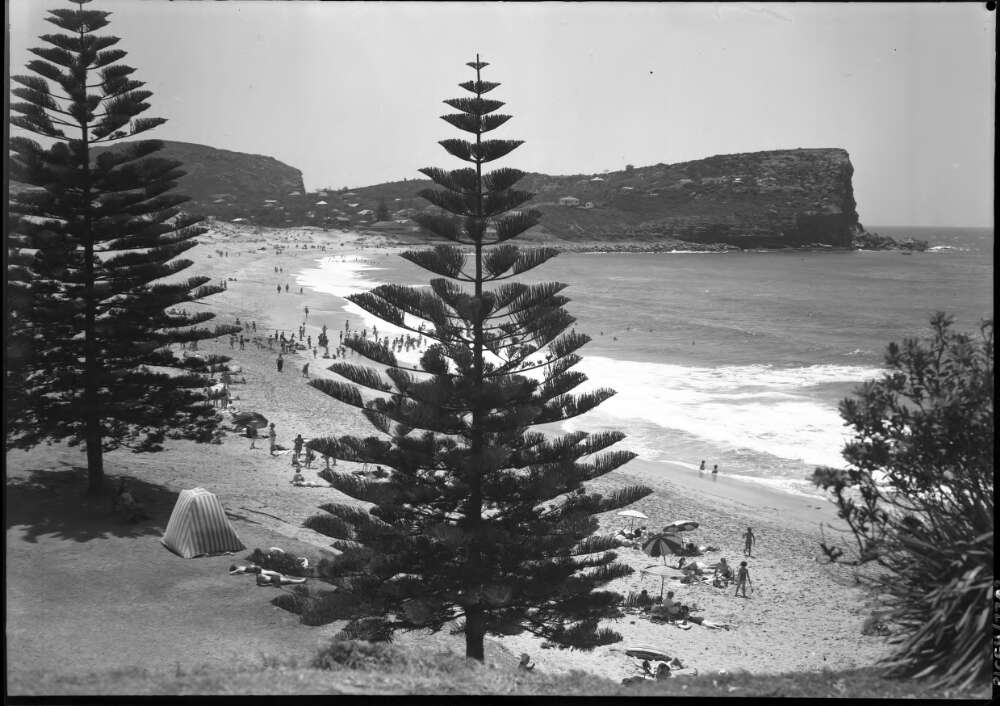

And 1968 - Avalon Looking north west and showing original Wickham kiosk structure in reserve (at left side of photo). Gary Clist photo.:
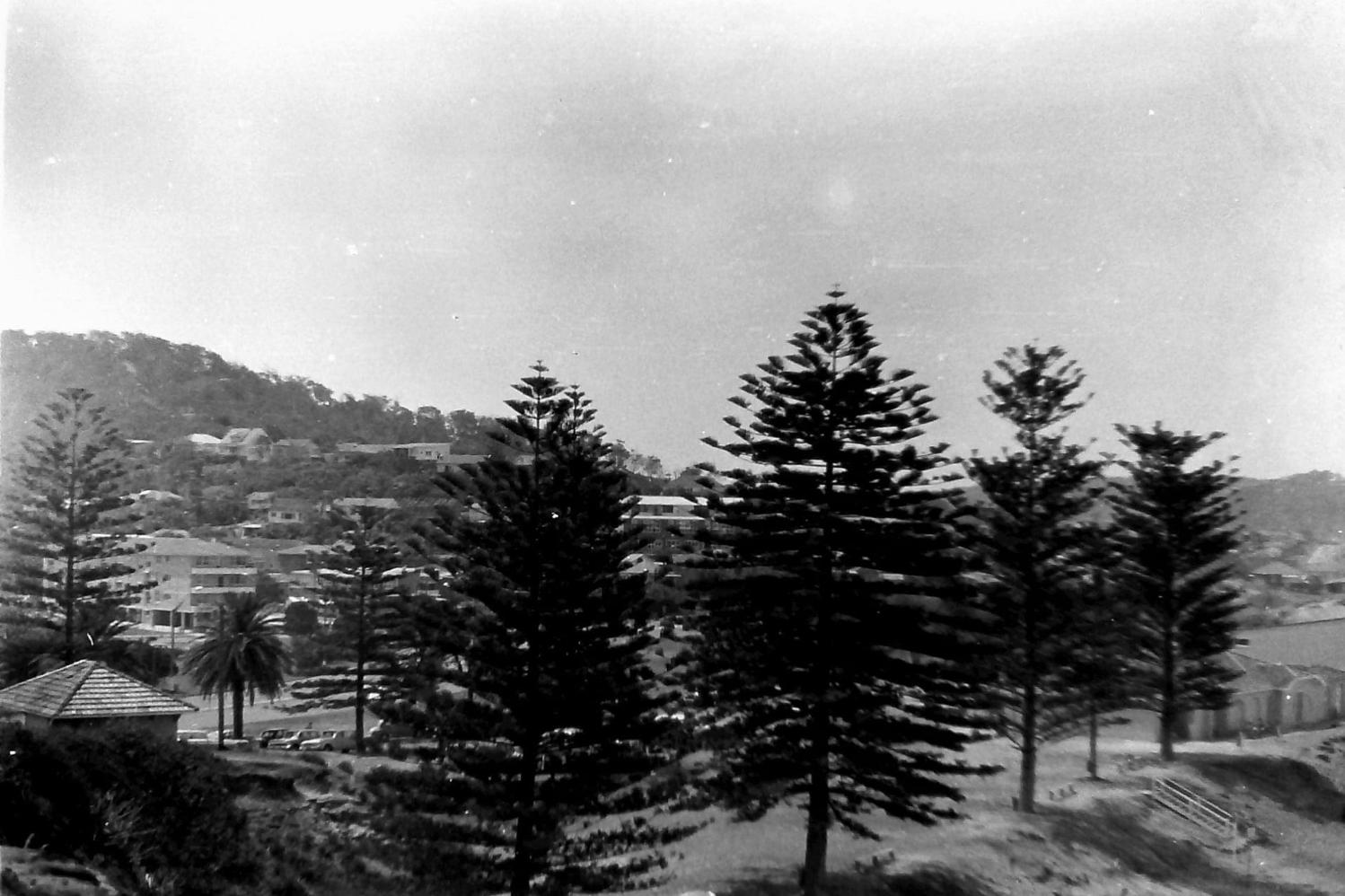
From Bangalley headland, 2024:
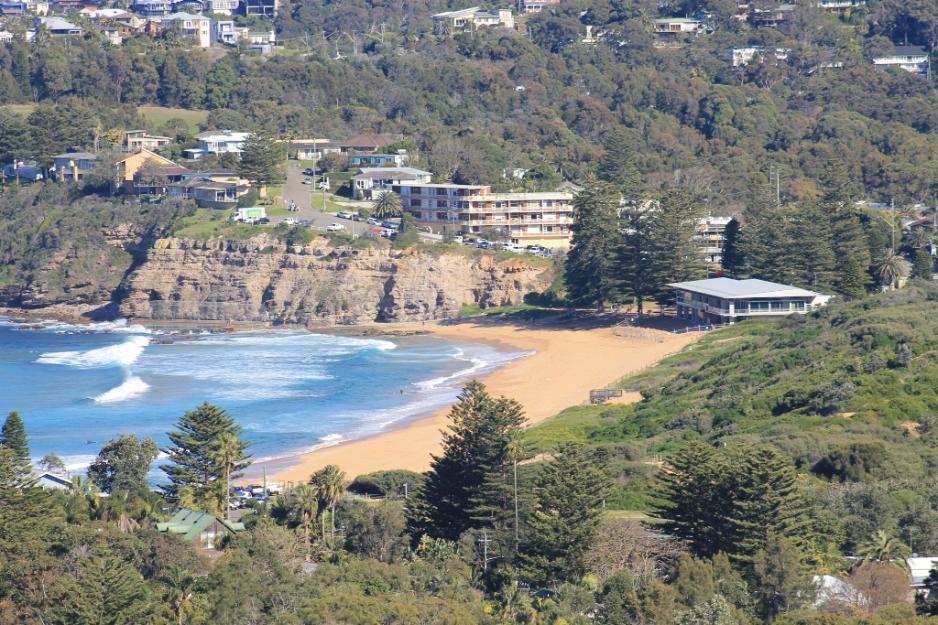
From south end looking north in 2018:
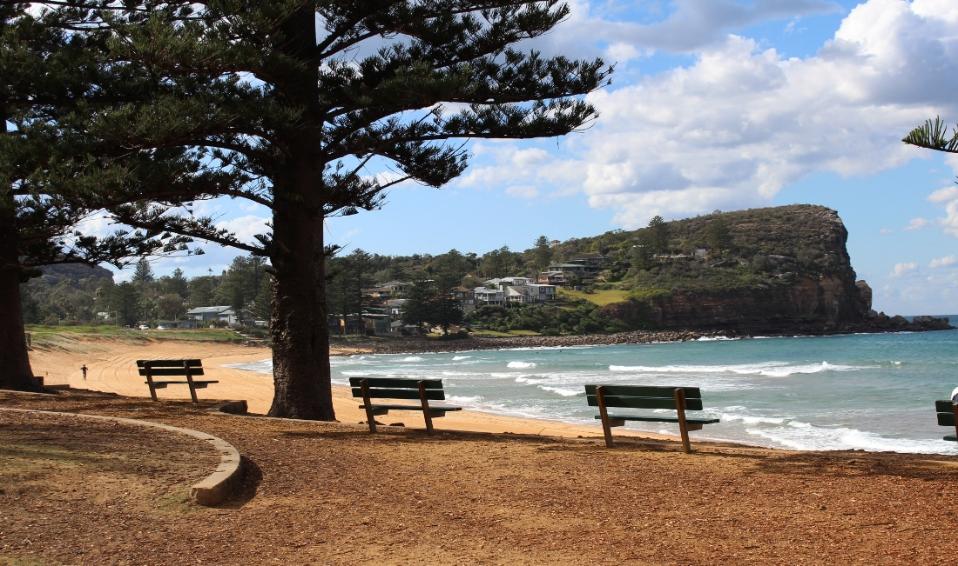
And Avalon beach – south end viewed from north end, January 2023, and view north from under these stately trees, February 2023:
The 'two rows of Norfolk pines' in 2023:
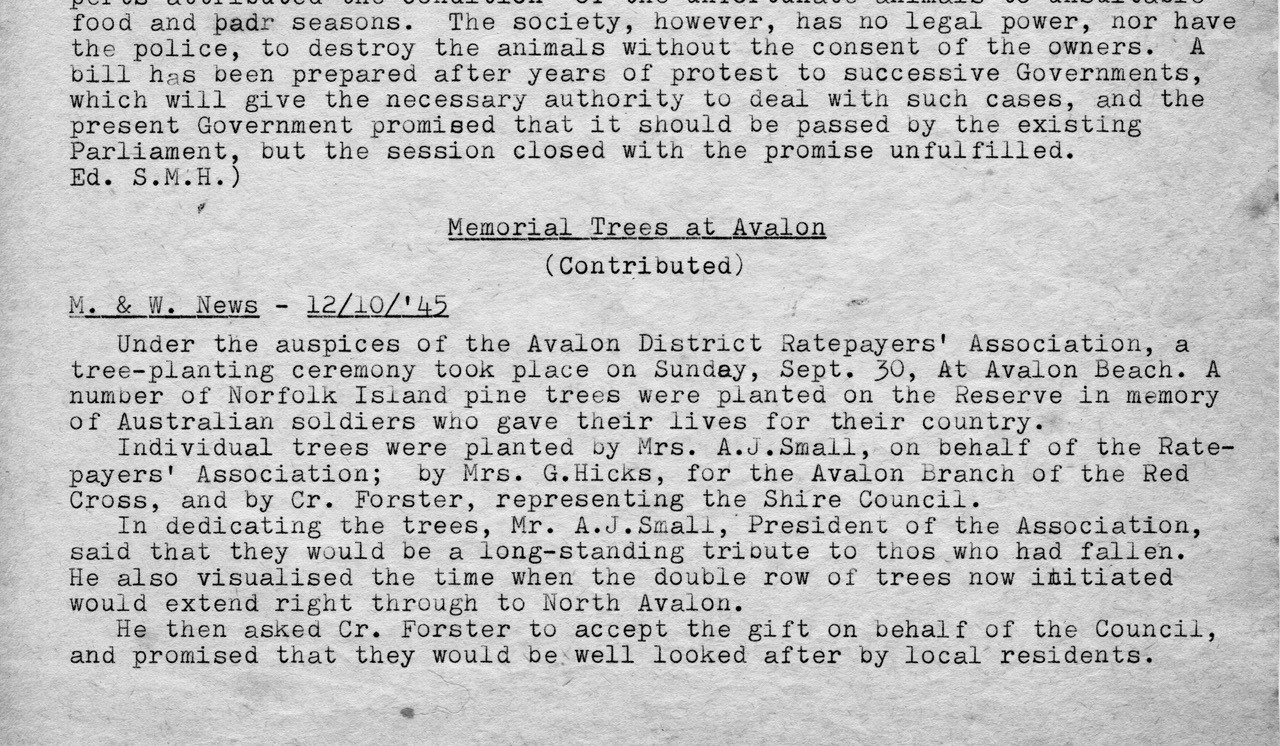
This was not the first time A J Small had planted trees in the valley of Avalon Beach and Clareville. When first commencing the land sales we see among the advertising and mentions in journals of the time:
Cronulla was, Palm Beach is, and Avalon Beach will be. This is the catch slogan which has been adopted by the vendor of the Palmgrove Estate at Avalon, which is to be sold by Messrs. H. W. Horning and Co., on Boxing Day. Judging by the beautiful panoramic views which appear in an attractive booklet, and which also occupy a conspicuous position in Messrs. Horning and Co.'s windows, Martin-place, the scenery surrounding the estate must be exceptionally beautiful. Avalon is the new seaside resort between Newport and Palm Beach. The Palmgrove Estate is on the main Barrenjoey-road, and is right at the beach.
The owner has evidently had the public good in mind, as the estate has been well planted with Ornamental shade trees, while a section of it known as the Palm Grove, has been presented as a park. This is a remarkable beauty spot, with a wealth of graceful palms, maidenhair, burrawang, and other ferns. The estate is in every respect a most attractive proposition to those looking for week-end and holiday sites. REAL ESTATE NEWS (1921, December 11). Sunday Times (Sydney, NSW : 1895 - 1930), p. 10. Retrieved from http://nla.gov.au/nla.news-article123241058
A few months later:
IMPROVING AVALON. ROADSIDE TREES PLANTED
Since the sale of Avalon Beach Estate at Christmas additions and improvements have been effected on the estate.
The rock pool baths at the southern end of the beach have been extended 18ft., and are now 57ft. long, with a smooth bottom. Ladies' dressing sheds have been erected immediately at the rear, on a spot once occupied by a jumble of rocks, and a general store and refreshment room of original design has been built close to the beach.
Several landowners are already building homes on their lots. A new, wide road has been constructed, giving the land direct access to the beach, and at the side of all the roads, trees, of eight different varieties, chosen as specially suitable for the land and atmosphere, have been planted. One of these is the Illawarra Flame Tree, which carries blooms of fire color. IMPROVING AVALON (1922, March 22). The Sun (Sydney, NSW : 1910 - 1954), p. 10 (FINAL RACING). Retrieved from http://nla.gov.au/nla.news-article225222882
The Avalon Beach RSL Club, formed by the Returned Servicemen in 1947, held the first official meeting was held at the rear of the general store and later at the Avalon Golf course. Jan Roberts' father, Frank Coleman, a WWII RAAF and RAF man, was the inaugural President.
As Jan explained in her Profile, to Did your father show any signs of having been affected by the war?
Yes, he was definitely affected but I think like many families, and many war babies, you don’t put it together until much later. One of my aunts said he was a different person when he came back. Most of his squadron didn’t make it back and being a Rear Gunner was probably one of the most dangerous jobs in the war because that was the one they tried to get rid of. He had many narrow escapes and was so traumatised that - and I didn’t find this out until quite recently when one of my uncles told me - when they did return to Australia, and landed in Western Australia, by plane – a very long air hop, we have a certificate on that - he refused to get on another plane. He thought he might be testing his luck too much and insisted on catching the train back. This meant that he was a little bit later then he as meant to be but at least he felt that he would make it back to Sydney!
The Avalon Beach RSL Club was officially formalised in 1950, with 60 members, who purchased a temporary shed, which still stands in Dunbar Park. Geoof Searl OAM states the original Avalon Beach RSL was in a fabricated shed, most likely from the Air Force training allotments in Ruskin Rowe during WWII.
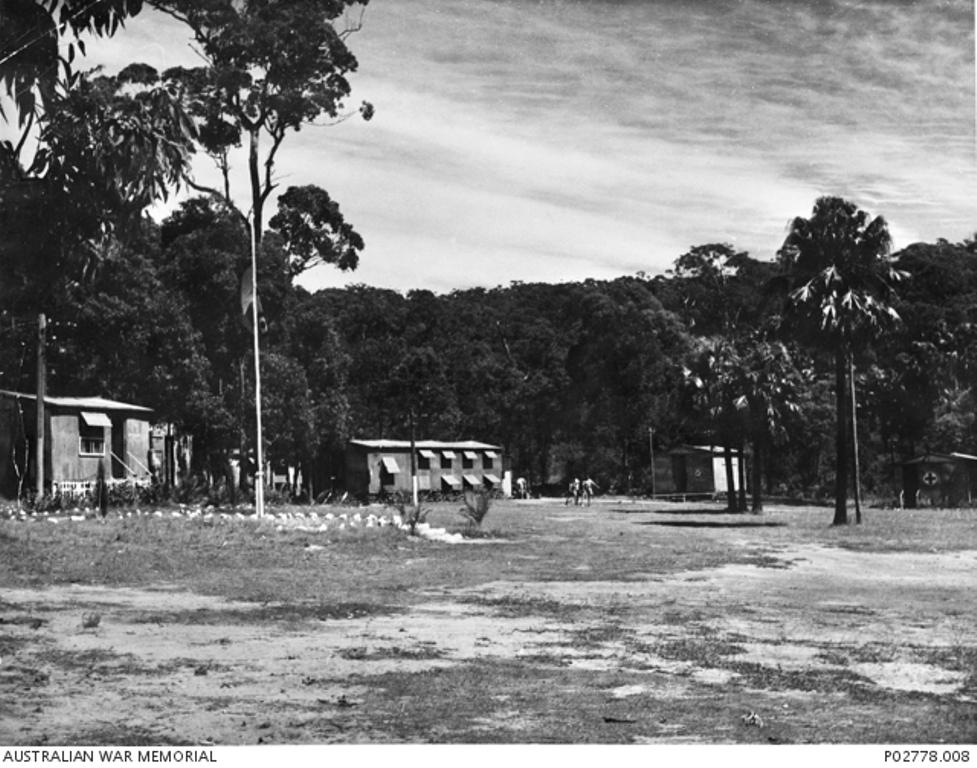
A building used as the Scout Hall for many years was also a possibility for RSL meetings - this was renovated as part of the Plan of Management for Dunbar Park by Pittwater Council in 2012.
Old Warringah Shire Council records show that Avalon Boy Scouts Committee wrote, dated 5/9/52, stating that advice of the Council's intention to postpone consideration of the granting of land for a Scout Hall at Avalon until receipt of the Progress Association's "overall plan" for Dunbar Park, has been received with regret; contending that the Association does not necessarily represent the true wishes of the population of Avalon in this matter and that the Scout movement at Avalon represents directly at least 60 families, and that the Committee has raised about £800 towards the cost of building, and that building plans has been submitted to the Council; and requesting that the Council reconsider its original suggestion for a grant of Scouts land in Barrenjoey Road.
In July 1953 it was resolved they could build a hall 'on Council's land' as long as the space in questions was filled in as required by the Department of Health, the area chosen being subject to floods and sitting in an old creek bed, as Avalon Guide Hall was when first built too.
One newspaper report states the council was going to allocate £5000.00 for this edifice - nothing could be found to indicate it was.
Avalon Beach "Scouts are to have a Scout Hall built in Barrenjoey Rd., Avalon Beach, at a cost of £5,000. OPPORTUNITIES FOR BUSINESS (1953, November 18). Construction (Sydney, NSW : 1938 - 1954), p. 9. Retrieved from http://nla.gov.au/nla.news-article222899341
Geoff Searl OAM, ABHS President provides this insight:
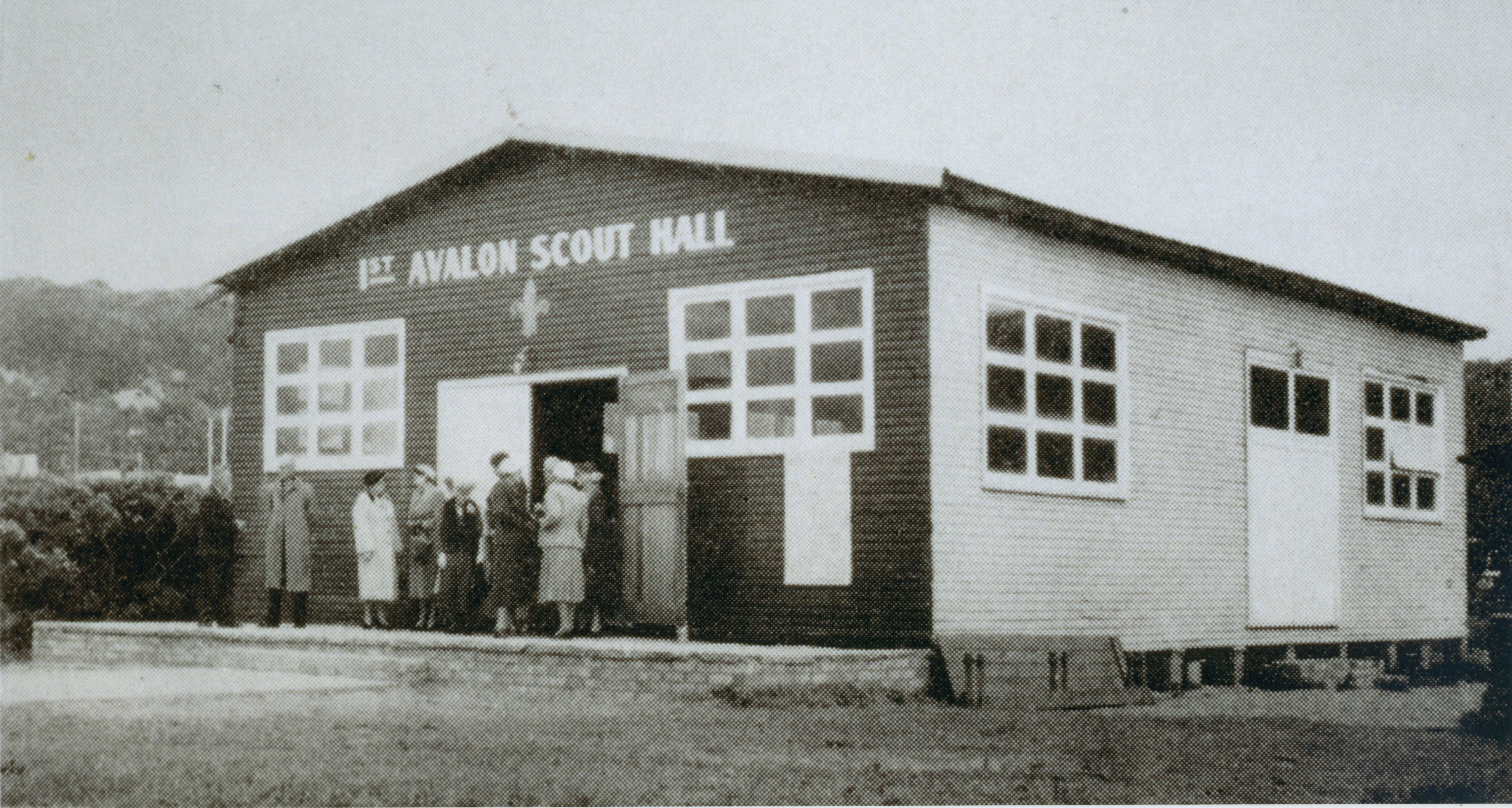
Avalon Scout Hall - photo courtesy Geoff Searl, ABHS
In 1954 the Scout Hall was originally built in Dunbar Park, with its two front doors facing east on Old Barrenjoey Road (approximately where the entrance to the Recreation Centre is now located). It was later moved to make way for the new and first Community Centre to the southern side of Dunbar Park with its front doors facing north. In the 1990s it was relocated a second time to its present site in the north west corner of Dunbar Park with its doors facing west. It has been totally reworked and is now referred to as the Annexe of the Recreation Centre.
By August 1958 the Council had forwarded Notice of Intention to Resume on the owner of Lot 15, D.P.9151, Barrenjoey Road, Avalon (Mrs. Inez D.White - a lady who lived at Terrey Hills) for the purposes of Section 348 (recreation, etc). The land is zoned as Open Space, and is on the western side of Barrenjoey Road between the shops and the Scout Hall. Council decided, on the recommendation of the TP.D. Committee 2/6/58 (Min.8) that Lot 15 be adopted as the best site for a rest park and public conveniences, that its acquisition be expedited and that plans be prepared for the conveniences. This response was to calm J. Harry, of Elouera Road, Avalon Beach, and Messrs .A.E.& M.M. Geake, Avalon Health Foods, and two other lessees of the shops in question who were protesting against the Council's proposal to erect public conveniences on land adjoining these premises.
Members of the Avalon Beach Beautification Scheme, (letter dated 21.11.61) were advising Council the Committee ''views with alarm the decision forced upon the Council by a Court decision to open Old Barrenjoey Road at the north section of Old & New Barrenjoey Roads opposite the Fire Station, as the planning of the layout of amenities and beautification of this area was on both beauty and safety for adults and Children and it is felt that the opening of this-road has produced a safety hazard, as this area contains a Village Green, Scouts, Hall, Girl Guides, Kiddies Playground and proposed Baby Health Centre and public tenets. They added the Committee trusts that every effort will be made by Council to have this decision rescinded.''
As most residents know, that road is now open. There is also a record that the hall was moved in 1968 to its present position with its flagstone entrance and flagpole moved too.
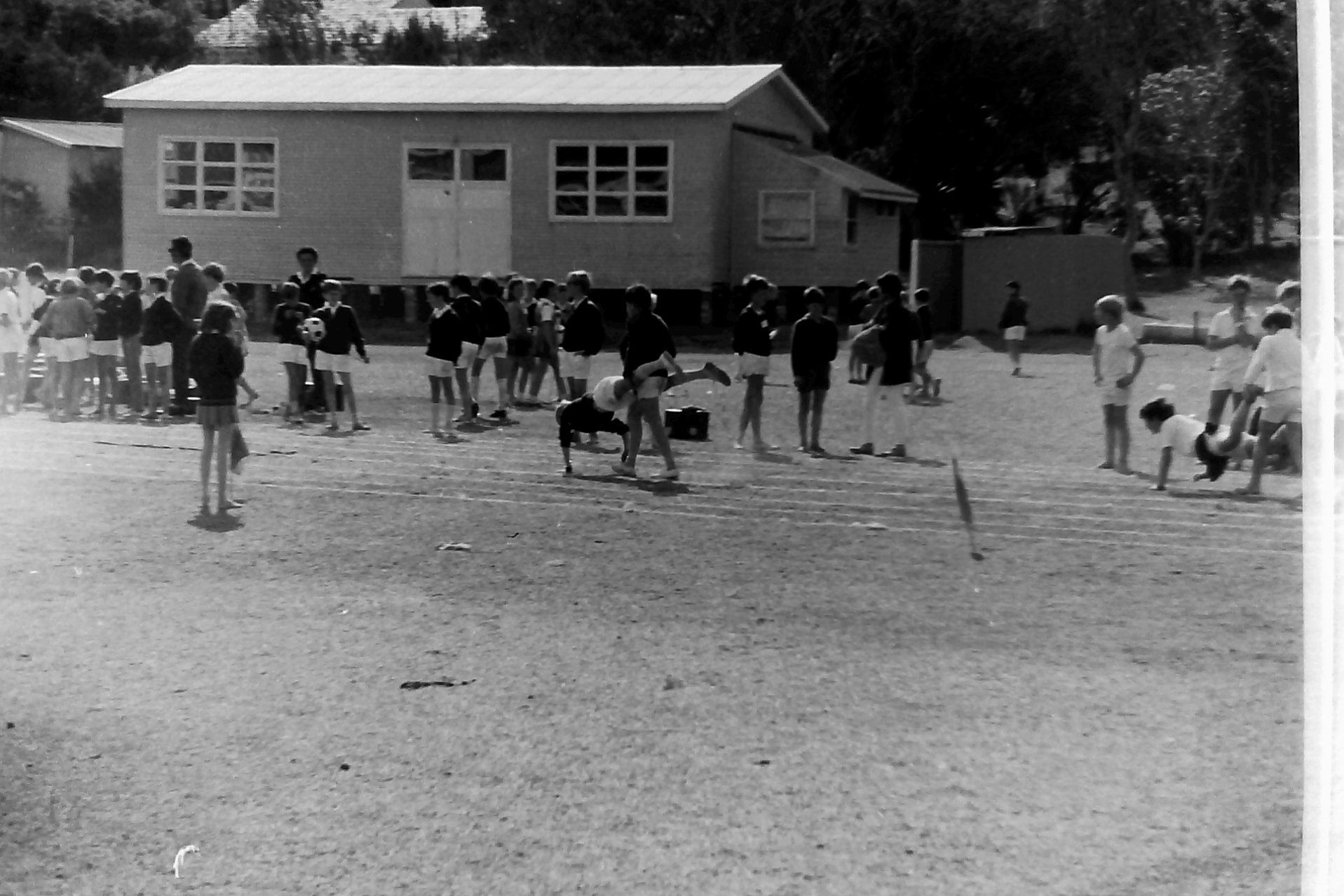
1970s Avalon Public School sports day in Dunbar Park - Scout Hall in background, photo courtesy Gary Clist
John W. Stone's photos of earlier Avalon Beach ANZAC Day Commemorative Services – “one of these from 1968 is a favourite. These are Pittwater High School they had Cadets at that stage.” (Taken from upper storey of then fairly new Avalon Beach RSL building.
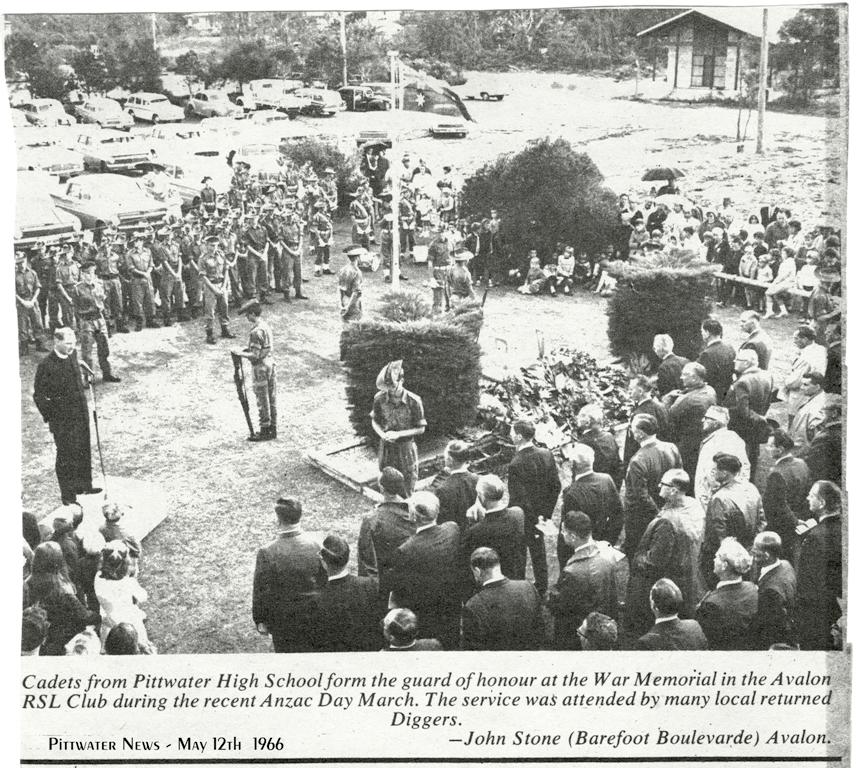
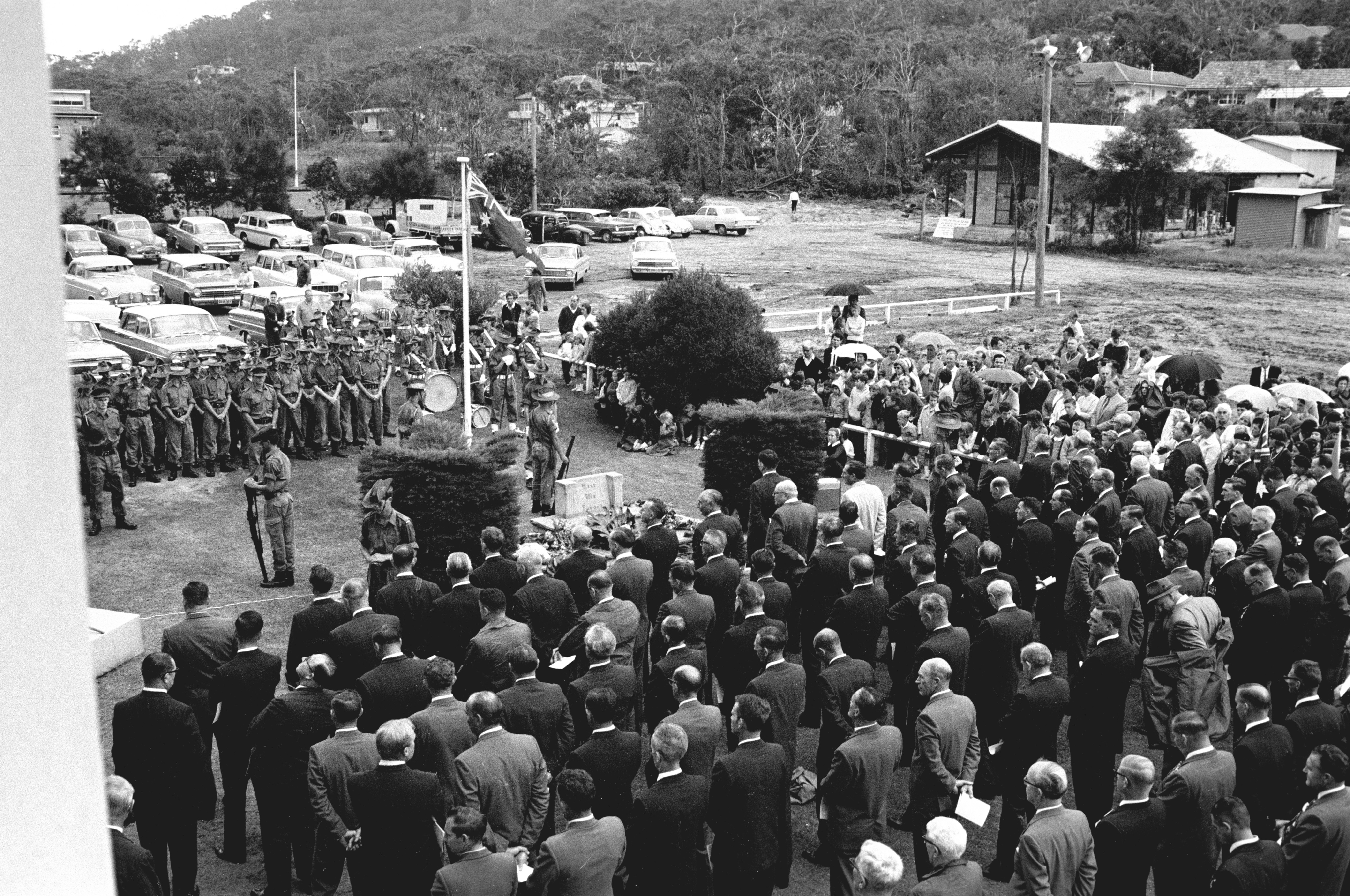
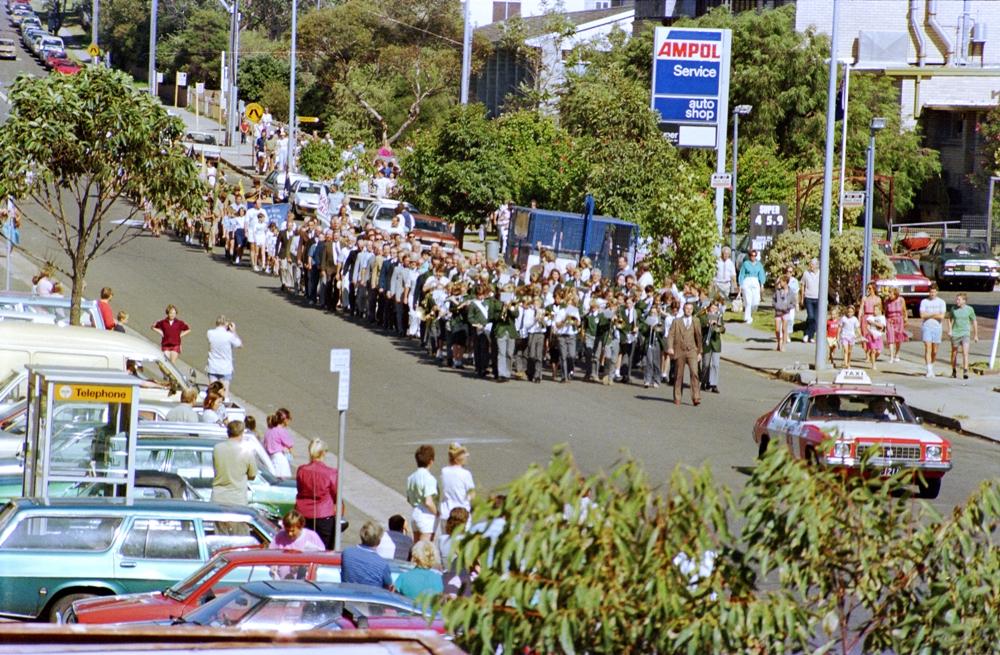
In good conditions Norfolk Island pines will live for 100+ years and attain heights of over 40 metres with canopy spread over 15 metres.
The species is labelled as “vulnerable” and is a threatened species in its native island of Norfolk Island due to heavy harvesting in the past few hundred years. Protective measures have been taken to protect what’s left of this tree in its endemic homeland.
The south end of Avalon Beach's park reserve space now has a number of tributes and celebrations of local culture. Thanks to the work of the community, and Roger Sayers OAM, Life Member of the club along with the support of the Avalon Preservation Association and backed up by the work of Avalon Beach Historical Society President Geoff Searl OAM, there are now informative markers along with tributes to loved ones.
In November 2019 Trudie’s Whale Sculpture was placed at South Avalon Beach this week, next to the path on the way to the pool.
Also in 2019 a Plaque was Unveiled To Mark Phenomenal Surfing Revolution Commencement - the Mal! This was followed by the 2021 installation of a Heritage Marker For Old Kiosk that was part of the reserve, and remnants of one version you can still see today. In 2022 Council installed 'Whale Songs' by Frances Belle Parker with Urban Art Projects.
However the first and lasting LIVING memorial was that row of five Norfolk Pines dedicated to Those Who Served and serve still - a fitting tribute that still towers over all those who gather to play, to speak, to hold seasonal ceremonies and events, such as the annual Carols at the Beach, in this park reserve beside the beach.
references - Extras
[1.] “Manly-Warringah had at least four Avenues of Honour planted between 1922 and 1933: at Soldier’s Avenue, Harbord(Freshwater), (circa 1922); Condamine Street, Balgowlah (1925-26); Pittwater Road, Collaroy (circa 1925-26); and the School of Artillery, North Head (1933)”.
“The first avenue was planted around 1922 in Soldier’s Avenue, Harbord, following its renaming from Matheson Street by community request. Local historian Gwen Gordon records that the first tree on the corner of Soldier’s Avenue and Oliver Street was planted in memory of fallen servicemen from Freshwater Surf life Saving Club (11). The local Oddfellows’ Lodge and Harbord citizens planted another, “Our Heroes Tree”, near the site of the first local Anzac Day service on a vacant lot in Soldier’s Avenue. Further trees were planted each side of Soldiers Avenue, between Oliver Street and Albert Street. Each tree guard carried a plaque with the name of a fallen soldier”.
“For many years, wreaths and flowers were placed at the foot of the trees on Anzac Day. In 1985, remaining tree guards and plaques were removed by Warringah Council. Replacement plaques are set now in the Wall of Remembrance provided by Harbord Diggers Memorial Club in conjunction with Council in Jacka Park”. - Manly Library Local Studies.
- Avalon's Village Green: Avalon Park Becomes Dunbar Park - Some History + Toongari Reserve And Catalpa Reserve
- Photographers Of Early Pittwater: David 'Rex' Hazlewood
- Avalon Beach Surf Life Saving Club - The First Clubhouse
- Avalon Beach Surf Life Saving Club - The Second and Third Clubhouses
- Avalon Beach Sand Dunes: Some History
- Avalon Beach Village Shops: Some History
- Anthony Thomas Ruskin Rowe, Spitfire Pilot (1919 To 1943) - Who Defended Darwin And His Mate: An Avalon Beach and Pittwater Hero
- Ruskin Rowe lots of land bought in Gunjulla page; Pittwater Summer Houses: Gunjulla, Avalon Beach-Clareville by Helen and Deborah Grant
- Ruskin Rowe training camp mention by Reg Wood in his Profile and also more available in: Muriel Knox Doherty Of Avalon Beach and Pittwater Aviatrixes On The Eve Of The RAAF's 100th: A NSW Women's Week - Women Of Aviation Week Celebration
- TROVE - National Library of Australia
- State Library of NSW - digitised records
- Geoff Searl OAM, President of Avalon Beach Historical Society
- Avalon Beach SLSC 90th Anniversary Exhibition And Celebrations; May 1-3, 2015 - The Hanson Boys by Geoff Searl
- Avalon Beach Reserve Heritage Marker For Old Kiosk Installed
- Plaque Unveiled To Mark Phenomenal Surfing Revolution Commencement
- Carols At The Beach 2019
- Living Ocean's Traditional Welcome To Country For The Southern Humpback Whale Migration + First Plastics Count For The Careel Multi-Layered Coastal Assessment
- Art News: September 2022
- Barley Ki Giballee: You And Me Come Together, The Exhibition - Avalon 100 Celebrations (2021 - 2022)
- Jan Roberts - Profile - 2013 version
- Doug Crane Classic Celebrates Its 20th Year: The History Of This Great Swim + Doug's Profile From 2011
- Reginald Charles Wood (Reg) - Profile
- Don Imison - Profile
- John W. Stone - Profile
The ATC Camp in Ruskin Rowe during WWII:
How A. T. C. Trains Fledglings Far Future Service In The Air
Nowadays when a rookie enters the R.A.A.F. it's two to one that he enters with a good idea of what to expect in the Service. Not only has he done preliminary training in technical subjects, but he's well primed on Service routine, down to details like folding his blankets in the miraculously neat Service manner.
HE knows all about such Service mysteries as substantive, temporary, and acting ranks, and he can talk glibly in that language of initials so beloved of the Services, and so maddening to female companions.
All this is due to the Air Training Corps-for boys between 16 and 18 - which has supplied 5000 R.A.A.F. enlistments for the Commonwealth, and which keeps up a steady flow of the Service intake. Recently one month's figures showed that 70 per cent, of the in-take for air crew was drawn from the A.T.C. Permanent camp
AT Avalon, N.S.W., there is a camp for these lads. The Avalon camp is the only permanent A.T.C. camp in Australia, and has an ' R.A.A.F. staff. A steady flow of .A.T.C. squadrons from all over the State passes through this camp, each group spending a week.
When the boys go into this camp, with its Service-style huts set in a glade among cabbage palms and flowering gums, and within a mile of th»- sea, the first thing they're told is that this week isn't going to be a holiday.
They find their day lasts from 6 a.m. to 10.30 p.m., that it follows closely the routine of physical training, study, and fatigues that they'll have when they enter their R.AA.F. rookie ramp.
"It isn't a loaf, if that's what you mean by a holiday," said one lad, "but it'll do me."
A smart 16-year-old sentry salutes at the entrance. He sets the keynote for a camp which, except for the youth of its inmates and perhaps just a little less formality, conforms in every respect to an adult establishment. That is, it conforms outwardly. There is the notable variation that the boys LIKE guard duty.
Once an exasperated A.T.C. instructor said to some rookies: "If you fellows don't behave I'll put you all on guard duty."
"Can we?" shouted the boys.
At sixteen, handling a Service rifle for two hours at a stretch isn't a duty-it's a pleasure.
Nor are there any provosts in the A.T.C. Officers use the honor system. It rarely fails.
Camp Commandant Flying Officer E. Wood, R.A.A.F., has served with a famous bomber squadron in Northern Australia, and saw four years' active service with the A.IF. in the last war.
The Service lectures which he gives are among the most popular of the evening series of lectures, for he has a fund of stories about famous air aces whom he has known. He tells the boys of the comrade-ship between air crew and ground staff at operational stations, and of deeds by ground staff no less gallant than those of pilots.
One of the first things the boys learn on entering camp is how to fold their three blankets and "box' them in a fourth, in Air Force style, and how to leave their huts for inspection. The sight of those huts in the morning, with knife, fork, and plate, and shining boots set out in front of the bedding is enough to arouse the envy of the mother of any average boy.
It is Sergeant C. Herbert, R.A.A.F., Warrant - Officer - Disciplinary, who teaches them these points, and is also their drill and physical training instructor.
English sergeant
SERGEANT HERBERT, Southampton-born, who can't be as young as he looks, for he was wounded four times in his service with the British Army in the last war, has a back like a ramrod. In between the wars he served on merchant ships, and in this war he has had plenty of experience drilling Air Force recruits.
In his spare time, Sergeant Herbert grows vegetables and flowers round the mess huts.
Boys from the farthest corners of N.S.W. come to this camp for a week's training during their term in the A.T.C. Some are schoolboys, while others are already earning their living and obtain holidays to join their squadron in camp. Many have elder brothers in the Air Force.
The day The Australian Women's Weekly visited the camp the occupants were of Squadron 43, which has its headquarters in Canberra. But when squadrons from the Far West come down they often include boys who have never seen a city, nor the sea, and even some who had not previously travelled In a train.
Their own A.T.C. officers accompany the boys to camp. These A.T.C. officers, many of them schoolmasters, are men who are doing a splendid job voluntarily, and have undertaken special training to fit them for the work.
R.A.A.F. sergeants are loaned to the camp to instruct in such subjects as small arms, unarmed combat, and navigation, and during the week a visit to an aerodrome, and usually a flight, is arranged as well.
Fatigues aren't more popular than in any camp, but since each boy spends only a half day on fatigues, and there is a scrupulous oversight to see that none gets more than his fair share of the "dirty work," the lads take it cheerfully. Kitchen fatigues mean plenty of assistants for the cook. Normally the cook is an R.A.A.F. corporal, but recently he has been relieved by an interesting personality in 60year-old Frank Royall. Frank Royall was chief steward in the Aurora during Sir Douglas Mawson's Antarctic expedition in 1912 to 1914, and has served with the U.S. Merchant Navy during this war.
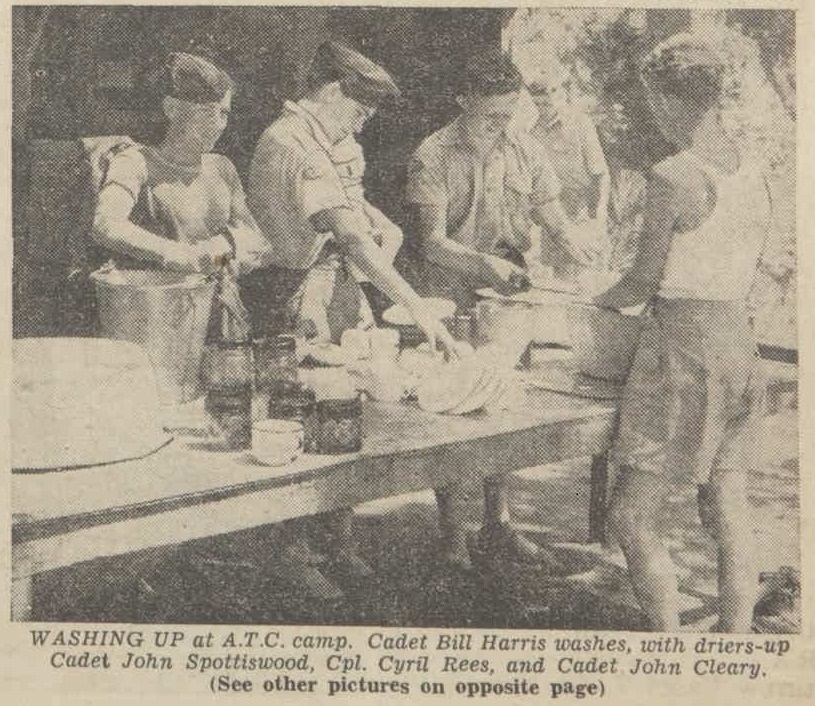
.jpg?timestamp=1615053202094)
.jpg?timestamp=1615053229444)
.jpg?timestamp=1615053255521)
.jpg?timestamp=1615053285654)
.jpg?timestamp=1615053307533)
.jpg?timestamp=1615053331537)
.jpg?timestamp=1615053365036)
.jpg?timestamp=1615053388267)
WASHING UP at A.T.C. camp. Cadet Bill Harris washes, with driers'-up Cadet John Spottiswood, Cpl. Cyril Rees, and Cadet John Cleary.
(See other pictures on opposite page)
I A.T.C. campers sample Air Force life
STATION PARADE and ceremony of raising of the ensign at Air Training Corps camp at Avalon, N.S.W. (See story of camp on opposite page.)
FIREWOOD FATIGUE. Cadets H. Burt and J. Boag saw a Iog of wood while Cadet Tom Emerson waits his turn
PEELING POTATOES. The cook, Frank Royall, shows Cadet David Benjamin how to do it, while Joe, the camp dog, looks on. Joe takes part in all parades.
UNARMED COMBAT. Sgt. T. Cowell, R.A.A.F., instructs Cpl. Ian Ray how to I throw Cadet J. Fitzpatrick.
SMART SALUTE from sentry, Sgt. Garnet Lewis, of Cess-nock, N.S.W., as an R.A.A.F. car enters the camp.
CANTEEN INTERVAL is enjoyed by Cpl. C. J. Rees, Cpl. P. J. Esdaile, Cadet A. D. Morris, and Cpl. W. A. Armstrong.
SHIP RECOGNITION is part of course. Here Flt.-Lieut. S. A. Broome, A.T.C., who is principal of Canberra Technical College, gives instruction.
ROPE CLIMB A boy of 16 15 feet, those of 17, 18,... (Pictures by A. Chambers.) How A. T. C. trains fledglings for future service in the air (1944, January 22). The Australian Women's Weekly (1933 - 1982), p. 12. Retrieved from http://nla.gov.au/nla.news-article46938279
